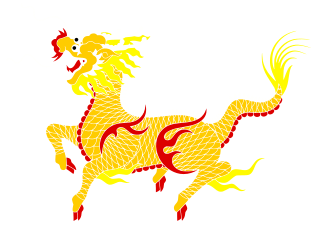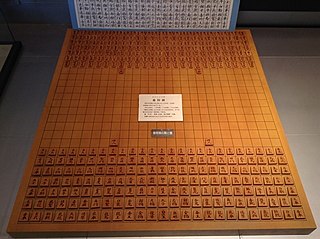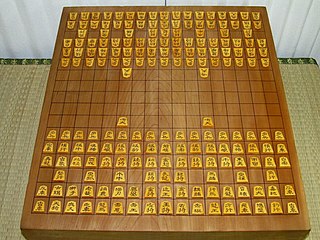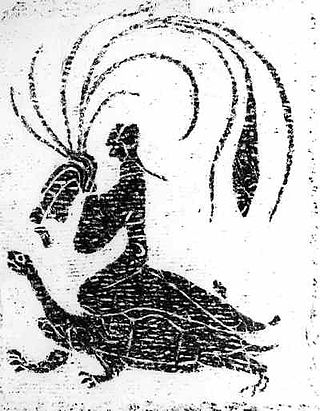Kirin may refer to:
Kirin may refer to:

Shogi, also known as Japanese chess, is a strategy board game for two players. It is one of the most popular board games in Japan and is in the same family of games as Western chess, chaturanga, xiangqi, Indian chess, and janggi. Shōgi means general's board game.
A monster is a type of fictional creature found in horror, fantasy, science fiction, folklore, mythology and religion.

The qilin is a legendary hooved chimerical creature that appears in Chinese mythology, and is said to appear with the imminent arrival or passing of a sage or illustrious ruler. Qilin are a specific type of the lin mythological family of one-horned beasts. The qilin also appears in the mythologies of other Chinese-influenced cultures.
A fairy chess piece, variant chess piece, unorthodox chess piece, or heterodox chess piece is a chess piece not used in conventional chess but incorporated into certain chess variants and some chess problems. Compared to conventional pieces, fairy pieces vary mostly in the way they move, but they may also follow special rules for capturing, promotions, etc. Because of the distributed and uncoordinated nature of unorthodox chess development, the same piece can have different names, and different pieces can have the same name in various contexts as it can be noted in the list of fairy chess pieces.

The Kirin Holdings Company, Limited. (キリンホールディングス株式会社) is a Japanese beer and beverage holding company. It is known for brands such as Kirin Beer, Kirin Lemon, Mets, and Gogo no Kōcha.

Chu shogi is a strategy board game native to Japan. It is similar to modern shogi in its rules and gameplay. Its name means "mid-sized shogi", from a time when there were three sizes of shogi variants that were regularly being played. Chu shogi seems to have been developed in the early 14th century as a derivative of dai shogi. There are earlier references, but it is not clear that they refer to the game as we now know it.

Tai shogi is a large board variant of shogi. The game dates to the 15th century and is based on earlier large-board shogi games. Before the discovery of taikyoku shogi in 1997, tai shogi was believed to be the largest playable chess variant, if not board game, ever. One game may be played over several long sessions and require each player to make over a thousand moves. It was never a popular game; indeed, a single production of six game sets in the early 17th century was a notable event.
Dai shogi or Kamakura dai shogi (鎌倉大将棋) is a chess variant native to Japan. It derived from Heian era shogi, and is similar to standard shogi in its rules and game play. Dai shogi is only one of several large board shogi variants. Its name means large shogi, from a time when there were three sizes of shogi games. Early versions of dai shogi can be traced back to the Kamakura period, from about AD 1230. It was the historical basis for the later, much more popular variant chu shogi, which shrinks the board and removes the weakest pieces.

Tenjiku shogi is a large-board variant of shogi. The game dates back to the 15th or 16th century and was based on the earlier chu shogi, which itself was based on dai shogi.

Dai dai shōgi is a large board variant of shogi. The game dates back to the 15th century and is based on the earlier dai shogi. Apart from its size, the major difference is in the range of the pieces and the "promotion by capture" rule. It is the smallest board variant to use this rule.

Maka dai dai shōgi is a large board variant of shogi. The game dates back to the 15th century and is based on dai dai shogi and the earlier dai shogi. The three Edo-era sources are not congruent in their descriptions of the pieces not found in smaller games. Apart from its size and number of pieces, the major difference from these smaller games is the "promotion by capture" rule. A more compact modern proposal for the game is called hishigata shogi.

The Great Yokai War is a 2005 Japanese fantasy film directed by Takashi Miike, produced by Kadokawa Pictures and distributed by Shochiku. The film stars Ryunosuke Kamiki, Hiroyuki Miyasako, Chiaki Kuriyama, and Mai Takahashi.
Girin may refer to:

The Taotie is an ancient Chinese mythological creature that was commonly emblazoned on bronze and other artifacts during the 1st millennium BC. Taotie are one of the "four evil creatures of the world". In Chinese classical texts such as the "Classic of Mountains and Seas", the fiend is named alongside the Hundun, Qiongqi, and Taowu. They are opposed by the Four Holy Creatures, the Azure Dragon, Vermilion Bird, White Tiger and Black Tortoise. The four fiends are also juxtaposed with the four benevolent animals which are Qilin, Dragon, Turtle and Fenghuang.

The X-Family is a Taiwanese drama starring Pauline Lan, Jiro Wang, Danson Tang, Sunnie Huang, Calvin Chen, and Aaron Yan. It is the sequel to the 2005 drama KO One and is produced by Comic International Productions. The series started filming in June 2006 and wrapped in April 2007. It was broadcast on cable TV Gala Television (GTV) Variety Show/CH 28 (八大綜合台) on August 8, 2007, to October 23, 2007.
Shogi is a two-player strategy board game in the same family as Western chess, chaturanga, and Chinese xiangqi, and is the most popular of a family of chess variants native to Japan.
The qilin is a creature in Chinese and other East Asian mythologies. It may refer to:

The spirit turtle or spirit tortoise is a turtle originated from Chinese mythology and spread with East Asian cultural sphere. It is believed by East Asian cultures, like other turtles in mythology, to represent longevity (壽命).

Fu Yu, known professionally as Wuheqilin is a Chinese illustrator and political cartoonist. His hometown is Harbin. He claims himself as a "Wolf warrior painter" and is famous in China for his artwork Peace Force, which depicts an Australian soldier killing an Afghan child.
麒麟, meaning qilin or giraffe, may refer to: